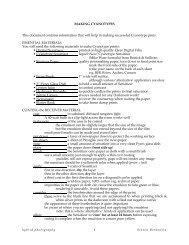Chapter Thirty Visual Culture/Visual Studies
Chapter Thirty Visual Culture/Visual Studies
Chapter Thirty Visual Culture/Visual Studies
Create successful ePaper yourself
Turn your PDF publications into a flip-book with our unique Google optimized e-Paper software.
moment), which have not yet secured solid standing as works of art. But it also stems from the<br />
fact that simple, everyday objects that have survived from distant times tend to assume, in our<br />
own day, the mantle of high art. Any potsherd miraculously preserved from ancient Egypt or<br />
classical Greece, any fragment of medieval tapestry or even simple cloth not destroyed during<br />
the rugged course of intervening centuries, today receives royal curatorial treatment and elicits<br />
no clucking when displayed at the Metropolitan Museum of Art or published in The Art<br />
Bulletin. In order to distinguish itself from a discipline that already claims most of the past as its<br />
own, visual studies often takes recourse to featuring objects of recent and abundant<br />
manufacture – films and photographs, advertisements and commercial goods – not yet valued<br />
for their rarity (with distressing regularity, a valuation confounded with aesthetic distinction). It<br />
is important to recognize that this tendency toward the modern is the result more of current<br />
academic jostling than of disciplinary imperatives internal to visual studies. <strong>Visual</strong> studies need<br />
not let go of the past.<br />
Second, in addition to expanding the range of domestic visual artifacts under<br />
consideration, visual studies also broadens the study of visual artifacts potentially to all corners<br />
of the world. Such global mindfulness is not without precedent: Euro-American art history<br />
departments in the postwar period have generally responded to the recognition (by Western<br />
scholars) of cultural activity in a previously under-acknowledged port of the world by<br />
appointing a specialist to cover the area – or at least by bemoaning the lack of funds that<br />
prevents them from doing so. Nonetheless, the Eurocentric origins of that established discipline,<br />
emerging as it did in the Continental nationalist movements of the nineteenth century, has<br />
repeatedly raised the specter that the discovery of art in societies outside the Occident entails<br />
the projection of a concept of great cultural specificity and considerable political charge –<br />
namely "art" – onto distant peoples among whom that idea of art may hold little or no currency.<br />
Consequently, historians of that thing called "art" frequently find themselves in a double cul-desac<br />
of the discipline's own making: no one would wish to insist that artifacts outside the<br />
Occident should conform to European aesthetic standards (that would be Eurocentric, if not<br />
indeed culturally imperialistic), yet neither would anyone want to suggest that such societies<br />
lack the capacity to perform at an aesthetic level comparable to the Occident (that would be<br />
condescending).<br />
<strong>Visual</strong> studies somewhat sidesteps this sort of impasse by defining its scope not in terms<br />
of a loaded cultural concept but rather according to a physiological characteristic of seeming<br />
transcultural application: the fact that people from oil parts of the world have eyes, and those<br />
eyes have the capacity to see. Not that visual studies would wish to assert some solid biological<br />
foundation to its activities. Different societies conceive of that basic ocular faculty – and use it as<br />
a metaphor for knowledge and other cultural practices – in radically different manners. For<br />
example, during European antiquity and the Middle Ages, sight frequently assumed the active<br />
character we now tend to associate with touch. Consequently, seeing and being seen frequently<br />
required strict social or religious regulation: fear of the piercing Evil Eye, for instance, prompted<br />
the wide dissemination of prophylactic talismans (a recent volume edited by Robert S. Nelson<br />
[2000] explores such variations in underlying assumptions about the visual). Nevertheless, the<br />
fact that any term used to designate a field of inquiry necessarily carries with it a certain<br />
cultural relativity hardly implies that all terms are culturally relative to an equal degree. And in<br />
some rather obvious sense the category of the visual breaks beyond the markedly Eurocentric –<br />
indeed postromantic – notion of art. Specifically, it opens up the field to a comparative study of<br />
the origins and functions of the aesthetic criteria of modern Euro-America – and also of other<br />
typologies and hierarchies generated by humans for the management of sight and of things<br />
seen.<br />
To engage the material culture of distant cultures and to forsake the object privileging<br />
concept of art, however, may drive visual studies into the fold of yet another discipline,







